SLLS632C December 2005 – February 2015 SN65HVD1050
PRODUCTION DATA.
- 1 Features
- 2 Applications
- 3 Description
- 4 Revision History
- 5 Description (Continued)
- 6 Pin Configuration and Functions
-
7 Specifications
- 7.1 Absolute Maximum Ratings
- 7.2 ESD Ratings
- 7.3 Recommended Operating Conditions
- 7.4 Thermal Information
- 7.5 Driver Electrical Characteristics
- 7.6 Receiver Electrical Characteristics
- 7.7 Device Switching Characteristics
- 7.8 Driver Switching Characteristics
- 7.9 Receiver Switching Characteristics
- 7.10 Supply Current
- 7.11 S-Pin Characteristics
- 7.12 VREF-Pin Characteristics
- 7.13 Typical Characteristics
- 8 Parameter Measurement Information
- 9 Detailed Description
- 10Application and Implementation
- 11Power Supply Recommendations
- 12Layout
- 13Device and Documentation Support
- 14Mechanical, Packaging, and Orderable Information
7 Specifications
7.1 Absolute Maximum Ratings(1)
| MIN | MAX | UNIT | ||||
|---|---|---|---|---|---|---|
| VCC | Supply voltage(2) | –0.3 | 7 | V | ||
| Voltage range at any bus terminal (CANH, CANL, Vref) | –27 | 40 | V | |||
| IO | Receiver output current | 20 | mA | |||
| VI | Voltage input, transient pulse(3) (CANH, CANL) | –200 | 200 | V | ||
| VI | Voltage input range (TXD, S) | –0.5 | 6 | V | ||
| TJ | Junction temperature | –55 | 170 | °C | ||
| Tstg | Storage temperature | –40 | 125 | °C | ||
(1) Stresses beyond those listed under Absolute Maximum Ratings may cause permanent damage to the device. These are stress ratings only and functional operation of the device at these or any other conditions beyond those indicated under Recommended Operating Conditions is not implied. Exposure to absolute-maximum-rated conditions for extended periods may affect device reliability.
(2) All voltage values, except differential I/O bus voltages, are with respect to network ground terminal.
(3) Tested in accordance with ISO 7637, test pulses 1, 2, 3a, 3b, 5, 6, and 7.
7.2 ESD Ratings
| VALUE | UNIT | ||||
|---|---|---|---|---|---|
| V(ESD) | Electrostatic discharge | Human body model (HBM), per ANSI/ESDA/JEDEC JS-001(1) | All pins | ±8000 | V |
| Bus pins vs GND | ±4000 | ||||
| Charged-device model (CDM), per JEDEC specification JESD22-C101(2) | ±1500 | ||||
| Machine Model, ANSI/ESDS5.2-1996 | ±200 | ||||
(1) JEDEC document JEP155 states that 500-V HBM allows safe manufacturing with a standard ESD control process.
(2) JEDEC document JEP157 states that 250-V CDM allows safe manufacturing with a standard ESD control process.
7.3 Recommended Operating Conditions
| MIN | NOM | MAX | UNIT | ||||
|---|---|---|---|---|---|---|---|
| VCC | Supply voltage | 4.5 | 5.5 | V | |||
| VI or VIC | Voltage at any bus terminal (separately or common mode) | –12 | 12 | V | |||
| VIH | High-level input voltage | TXD, S | 2.1 | VCC | V | ||
| VIL | Low-level input voltage | 0 | 0.8 | V | |||
| VID | Differential input voltage | –7 | 7 | V | |||
| IOH | High-level output current | Driver | –70 | mA | |||
| Receiver | –2 | ||||||
| IOL | Low-level output current | Driver | 70 | mA | |||
| Receiver | 2 | ||||||
| TJ | Junction temperature | See Absolute Maximum Ratings, 1-Mbps minimum signaling rate with RL = 54 Ω | –40 | 150 | °C | ||
| Signaling Rate | 20 | kbps | |||||
7.4 Thermal Information
| THERMAL METRIC(1) | SN65HVD1050 | UNIT | |
|---|---|---|---|
| D (SOIC) | |||
| 8 PINS | |||
| RθJA | Junction-to-air, Low-K thermal resistance(2) | 211 | °C/W |
| Junction-to-air, High-K thermal resistance | 131 | ||
| RθJC(top) | Junction-to-case (top) thermal resistance | 79 | |
| RθJB | Junction-to-board thermal resistance | 53 | |
| ψJT | Junction-to-top characterization parameter | 10.3 | |
| ψJB | Junction-to-board characterization parameter | 56.6 | |
| RθJC(bot) | Junction-to-case (bottom) thermal resistance | 112 | |
| PD | Average power dissipation, VCC = 5.0V, Tj = 27°C, RL = 60 Ω, S at 0V, Input to TXD a 500 kHz, 50% duty cycle square wave. CL at RXD = 15 pF | 170 | mW |
| Average power dissipation, VCC = 5.5V, Tj = 130°C, RL = 45 Ω, S at 0V, Input to TXD a 500 kHz, 50% duty cycle square wave. CL at RXD = 15 pF | 170 | ||
| TJ_shutdown | Junction temperature, thermal shutdown(3) | 190 | °C |
(1) For more information about traditional and new thermal metrics, see the IC Package Thermal Metrics application report, SPRA953.
(2) Tested in accordance with the Low-K or High-K thermal metric definitions of EIA/JESD51-3 for leaded surface-mount packages.
(3) Extended operation in thermal shutdown may affect device reliability, see APPLICATIONS INFORMATION.
7.5 Driver Electrical Characteristics
over recommended operating conditiions (unless otherwise noted)| PARAMETER | TEST CONDITIONS | MIN | TYP(1) | MAX | UNIT | |||
|---|---|---|---|---|---|---|---|---|
| VO(D) | Bus output voltage (Dominant) | CANH | VI = 0V, S at 0V, RL = 60 Ω, See Figure 11 and Figure 12 | 4.75V < VCC < 5.25V | 2.9 | 3.4 | 4.5 | V |
| 4.5V < VCC < 5.5V | 2.75 | 5.2 | ||||||
| CANL | 4.75V < VCC < 5.25V | 0.8 | 1.5 | |||||
| 4.5V < VCC < 5.5V | 1.6 | |||||||
| VO(R) | Bus output voltage (Recessive) | VI = 3V, S at 0V, RL = 60 Ω, See Figure 11 and Figure 12 | 4.75V < VCC < 5.25V | 2 | 2.3 | 3 | V | |
| 4.5V < VCC < 5.5V | 1.8 | 3 | ||||||
| VOD(D) | Differential output voltage (Dominant) | VI = 0V, RL = 60 Ω, S at 0V, See Figure 11, Figure 12, and Figure 13 | 4.75V < VCC < 5.25V | 1.5 | 3 | V | ||
| 4.5V < VCC < 5.5V | 1.4 | 3 | ||||||
| VI = 0V, RL = 45 Ω, S at 0V, See Figure 11, Figure 12, and Figure 13 | 4.75V < VCC < 5.25V | 1.4 | 3 | |||||
| 4.5V < VCC < 5.5V | 1.3 | 3 | ||||||
| VOD(R) | Differential output voltage (Recessive) | VI = 3V, S at 0V, See Figure 11 and Figure 12 | –0.012 | 0.012 | V | |||
| VI = 3V, S at 0V, No Load | –0.5 | 0.05 | ||||||
| VOC(ss) | Steady state common-mode output voltage | S at 0V, Figure 18 | 4.75V < VCC < 5.25V | 2 | 2.3 | 3 | V | |
| 4.5V < VCC < 5.5V | 1.9 | 3 | ||||||
| ΔVOC(ss) | Change in steady-state common-mode output voltage | 30 | mV | |||||
| IIH | High-level input current, TXD input | VI at VCC | –2 | 2 | μA | |||
| IIL | Low-level input current, TXD input | VI at 0V | –50 | –10 | ||||
| IO(off) | Power-off TXD output current | VCC at 0V, TXD at 5V | 1 | |||||
| IOS(ss) | Short-circuit steady-state output current | VCANH = -12V, CANL Open, See Figure 21 | –105 | –72 | mA | |||
| VCANH = 12V, CANL Open, SeeFigure 21 | 0.36 | 1 | ||||||
| VCANL = -12V, CANH Open, See Figure 21 | –1 | –0.5 | ||||||
| VCANL = 12V , CANH Open, See Figure 21 | 71 | 105 | ||||||
| CO | Output capacitance | See receiver input capacitance | ||||||
(1) All typical values are at 25°C with a 5-V supply.
7.6 Receiver Electrical Characteristics
over recommended operating conditions (unless otherwise noted)| PARAMETER | TEST CONDITIONS | MIN | TYP(1) | MAX | UNIT | |||
|---|---|---|---|---|---|---|---|---|
| VIT+ | Positive-going input threshold voltage | S at 0V, See Table 1 | 800 | 900 | mV | |||
| VIT– | Negative-going input threshold voltage | 500 | 650 | |||||
| Vhys | Hysteresis voltage (VIT+ – VIT–) | 100 | 125 | |||||
| VOH | High-level output voltage | IO = –2 mA, See Figure 16 | 4.75V < VCC < 5.25V | 4 | 4.6 | V | ||
| 4.5V < VCC < 5.5V | 3.8 | |||||||
| VOL | Low-level output voltage | IO = 2 mA, See Figure 16 | 0.2 | 0.4 | V | |||
| II(off) | Power-off bus input current | CANH or CANL = 5V, Other pin at 0V, VCC at 0V, TXD at 0V |
165 | 250 | μA | |||
| IO(off) | Power-off RXD leakage current | VCC at 0V, RXD at 5V | 20 | μA | ||||
| CI | Input capacitance to ground, (CANH or CANL) | TXD at 3V, VI = 0.4 sin (4E6πt) + 2.5V |
13 | pF | ||||
| CID | Differential input capacitance | TXD at 3V, VI = 0.4 sin (4E6πt) | 5 | |||||
| RID | Differential input resistance | TXD at 3V, S at 0V | 30 | 80 | kΩ | |||
| RIN | Input resistance, (CANH or CANL) | 15 | 30 | 40 | ||||
| RI(m) | Input resistance matching [1 – (RIN (CANH) / RIN (CANL))] x 100% |
V(CANH) = V(CANL) | –3% | 0% | 3% | |||
(1) All typical values are at 25°C with a 5-V supply.
7.7 Device Switching Characteristics
over operating free-air temperature range (unless otherwise noted)| PARAMETER | TEST CONDITIONS | MIN | TYP | MAX | UNIT | ||
|---|---|---|---|---|---|---|---|
| td(LOOP1) | Total loop delay, driver input to receiver output, recessive to dominant | Figure 19, S at 0V | 4.75V < VCC < 5.25V | 90 | 190 | ns | |
| 4.5V < VCC < 5.5V | 85 | 195 | |||||
| td(LOOP2) | Total loop delay, driver input to receiver output, dominant to recessive | 4.75V < VCC < 5.25V | 90 | 190 | |||
| 4.5V < VCC < 5.5V | 85 | 195 | |||||
7.8 Driver Switching Characteristics
over recommended operating conditions (unless otherwise noted)| PARAMETER | TEST CONDITIONS | MIN | TYP | MAX | UNIT | ||
|---|---|---|---|---|---|---|---|
| tPLH | Propagation delay time, low-to-high-level output | S at 0V, See Figure 14 | 25 | 65 | 120 | ns | |
| tPHL | Propagation delay time, high-to-low-level output | 25 | 45 | 90 | |||
| tr | Differential output signal rise time | 25 | |||||
| tf | Differential output signal fall time | 50 | |||||
| ten | Enable time from silent mode to dominant | See Figure 17 | 1 | μs | |||
| t(dom) | Dominant time-out | ↓VI, See Figure 20 | 4.75V < VCC < 5.25V | 300 | 450 | 700 | μs |
| 4.5V < VCC < 5.5V | 280 | 700 | |||||
7.9 Receiver Switching Characteristics
over recommended operating conditions (unless otherwise noted)| PARAMETER | TEST CONDITIONS | MIN | TYP | MAX | UNIT | ||
|---|---|---|---|---|---|---|---|
| tPLH | Propagation delay time, low-to-high-level output | S at 0V or VCC, See Figure 16 | 4.75V < VCC < 5.25V | 60 | 100 | 130 | ns |
| 4.5V < VCC < 5.5V | 60 | 135 | |||||
| tPHL | Propagation delay time, high-to-low-level output | 4.75V < VCC < 5.25V | 45 | 70 | 90 | ||
| 4.5V < VCC < 5.5V | 45 | 95 | |||||
| tr | Output signal rise time | 8 | |||||
| tf | Output signal fall time | 8 | |||||
7.10 Supply Current
over recommended operating conditions (unless otherwise noted)| PARAMETER | TEST CONDITIONS | MIN | TYP | MAX | UNIT | |||
|---|---|---|---|---|---|---|---|---|
| ICC | 5-V Supply current | Silent mode | S at VCC, VI = VCC | 6 | 10 | mA | ||
| Dominant | VI = 0V, 60 Ω Load, S at 0V | 4.75V < VCC < 5.25V | 50 | 70 | ||||
| 4.5V < VCC < 5.5V | 75 | |||||||
| Recessive | VI = VCC, No Load, S at 0V | 6 | 10 | |||||
7.11 S-Pin Characteristics
over recommended operating conditiions (unless otherwise noted)| PARAMETER | TEST CONDITIONS | MIN | TYP | MAX | UNIT | |
|---|---|---|---|---|---|---|
| IIH | High level input current | S at 2V | 20 | 40 | 70 | μA |
| IIL | Low level input current | S at 0.8V | 5 | 20 | 30 | |
7.12 VREF-Pin Characteristics
over operating free-air temperature range (unless otherwise noted)| PARAMETER | TEST CONDITIONS | MIN | TYP | MAX | UNIT | |
|---|---|---|---|---|---|---|
| VREF | Reference output voltage | –50 μA < IO < 50 μA | 0.4VCC | 0.5VCC | 0.6VCC | V |
7.13 Typical Characteristics
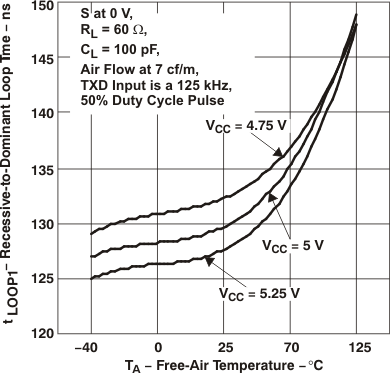
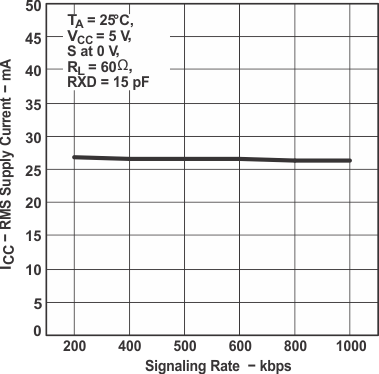
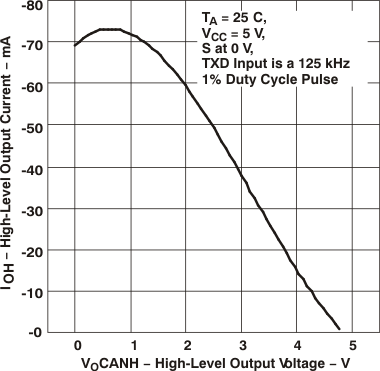
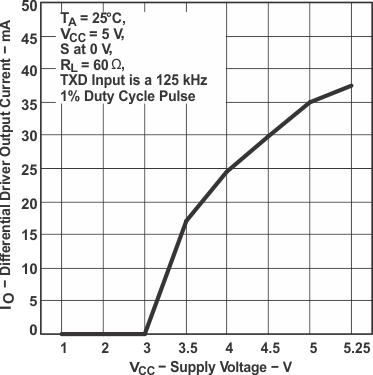 Figure 7. Driver Output Current vs Supply Voltage
Figure 7. Driver Output Current vs Supply Voltage
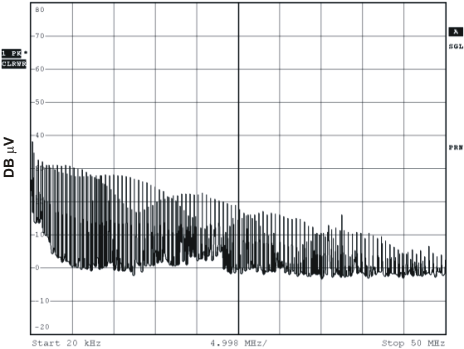 Figure 9. Frequency Spectrum of Common-Mode Emissions
Figure 9. Frequency Spectrum of Common-Mode Emissions
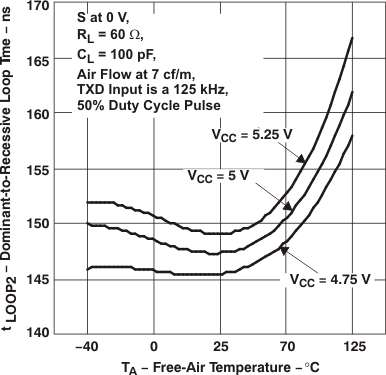
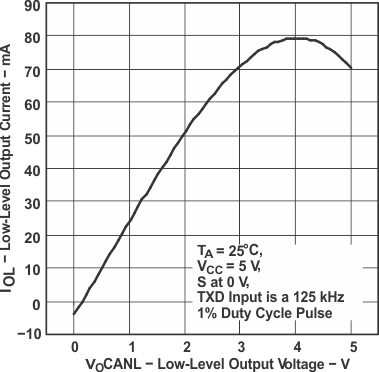
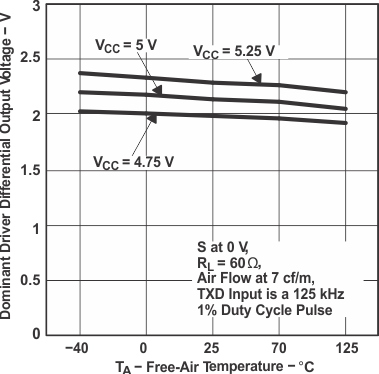
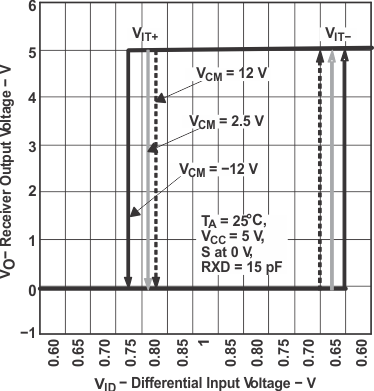 Figure 8. Receiver Output Voltage vs Differential Input Voltage
Figure 8. Receiver Output Voltage vs Differential Input Voltage
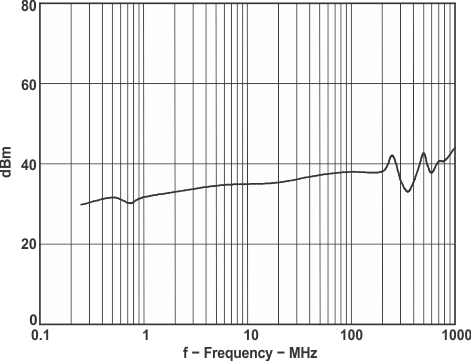 Figure 10. Direct Power Injection (DPI) Response vs Frequency
Figure 10. Direct Power Injection (DPI) Response vs Frequency